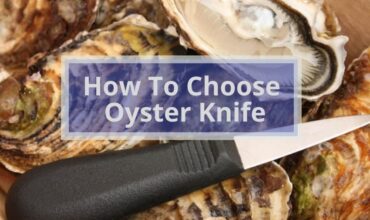How to shuck oysters without an oyster knife
We believe that everyone has the right to enjoy freshly shucked oysters whenever they want. Opening oysters at home is very satisfying, and we think that everyone deserves the chance to experience this pleasure. Today, we’re going to show you how to shuck an oyster at home, without any fancy equipment ( a cut-resistant glove or a rubber glove, or a good oyster knife).
There are several surprisingly easy ways to open your shellfish without using an oyster knife. And to make it easier on you, we are going to gather these methods with a brief about how to use each one so that you can choose the most suitable and safer way for you.
Substitutional solutions list of how to shuck oysters without an oyster knife
- A flat-head Screwdriver Method.
- Heat or Oven Method.
- A microwave Oven Method.
- Steam Method.
- Broiler or Grill Method.
- A paring knife Method.
- A Butter Knife.
A flat-head screwdriver Method
- You can use a flat-head screwdriver as its shape resembles a shucking knife. Use the shortest length flat-headed tool for this task so you guarantee a strong and safe grip. Don’t forget always to use a clean or a new screwdriver.
- To open the shell, hold the oyster firmly with a tea towel with the cupped side facing down and the flat side facing up. Start to twist the tip into the hinge until it clicks. Be careful not to use too much force and break the shell while opening it. At first, you will feel that the screwdriver is “stuck” before the shell opens. Use the blade of the screwdriver to detach oyster meat from the shell and then simply enjoy with some lemon wedges!
Read more, How To Shuck Oysters At Home
Heat or Oven Method
- We like this approach because it’s pretty easy for anyone to use. The idea works because we can exploit their natural ability to open their shells when exposed to sudden heat.
- Place about six oysters on an oven pan and try to maintain their stability to prevent the delicious oyster liquor from leaking out while being opened in the oven. As a solution, you can put a layer base of rough salt on the pan then place oysters on it.
- Put the pan in a hot preheated oven for about 4 minutes until the tops of oyster shells open up a little, then remove from the oven. Then gently poke a knife into the upper part of the shell and cut the muscle (adductor muscle) away.
- Remove the top half shell. Then remove the muscle from the bottom side. If you enjoy your oysters chilled, you’ll want to keep them in the refrigerator before catering them.
Check also , How to Buy, Clean, and Store Oysters?
A microwave Oven Method
- Essentially, the principle here is similar to the one we used when putting oysters in a really warm oven. When heated, the oyster shell expands, releasing its contents and letting out any steam that has built up inside.
- Wash them well and place them in a microwave-proof dish, preferably with some support so they don’t fall over when they open. Then turn the microwave to high and cook for 1.5- 2 minutes.
- Remove the oysters when they’re all opened up, so they don’t overcook and become chewy and rubbery. Finally, use a normal knife blade to complete opening them.
Steam Method
- Steaming is the easiest way to open an unopened oyster shell. We know that you would rather it not be hot, but this method is worth it.
- Get yourself a big container. Put the oysters into it and fill it with water so that it creates steam. Put the container on the bonfire and turn the heat up to medium. Cook for 5 to 7 minutes and make sure the water isn’t boiling over, then remove from the heat.
- The outer layer of the oyster will soften and it will be easy to open. Serve the shucked oyster chilled after putting them in the refrigerator.
Also read, The Wellfleet Puffer Petite Oysters
Broiler or Grill Method
- Like steaming, heating is one of the best ways to open a fresh oyster. You can use a broiler or grill for the job.
- Put the fresh oysters on a grill tray and grill them for a few minutes. While cooking your oysters make sure to place the hinges so they are visible while opening up.
- It’s best to cook them just long enough for them to be tender but not burned.
A paring knife Method
- Prepare your paring knife to shuck your oysters but make sure to clean them well by soaking them in salted water to remove any dirt on the shell.
- After that, observe the gap at the edge of the oyster’s shell. Use your kitchen towel to hold an oyster and squeeze your knife deep inside the shell. At this point, all you need is to rotate the blade slightly and the oyster shell will pop out. Keep Holding the knife close enough to the flat shell so that you can cut through the muscle connecting two pieces of oyster and finish the job by breaking the flat shell.
- If there is no gap at one end of an oyster or if the gap is too small to be separated by hand, for hard-shelled rock oysters, use a mallet to break the edge of an oyster, then follow these steps to separate the oyster.
Also read , How To Choose Oyster Knife
A Butter Knife
- Same as a paring knife, use your butter knife which is short with a rounded neither sharp nor serrated tip, you don’t need a sharp tool, to open your oysters. Insert your knife through the hinge with slight pressure and strength to get the job done.
- Before using a butter knife for shucking oysters, you need to know that there are disadvantages of using it as the following:
- The butter knife may be less effective than a shucking tool because the blade is weaker at the point where it meets the handle.
- If you have a poorly made butter knife with a poorly-attached handle when you try to use it to chuck an oyster, you might well find that the handle breaks off in your hand.
- If the handle and the blade of the knife are made of one piece of relatively inexpensive metal, you might attempt to waggle the blade only to find the handle moving with you and the blade remaining completely still.
Also check, What are the Benefits of Oysters?
FAQ About Oysters
How to store and shop for oysters ?
Oysters should be bought live, by law. Clamp them tightly shut. If they don’t close immediately when touched, they are dead and need to be avoided. Smell them, too. If there’s any kind of fishy scent, avoid them. Fresh oysters should smell like salted water. When buying them, make sure they are being kept in the store on crushed ice.
Oysters should be stored in a container without a tight-fitting lid. Put the top half of the shell down, and cover with a damp towel. Store in the fridge for up to a week before serving. Use oyster knife blades; a stainless steel blade is preferred, to shuck your oysters gently. Scrub off any dirt or debris from the shells. Serve a raw oyster with a squeeze of fresh lemon or cocktail sauce. Mignonette is optional.
What is the difference between East Coast oysters and West coast oysters ?
East Coast oysters are very salty and briny. Their saltiness comes from the water they were grown in. Their brine comes from the fact that they are harvested right after being shucked. This makes them taste fresh.
West coast oysters are soft, creamy, and mild-tasting. They can be found in many different types of dishes. You can find them in salads, soups, and even desserts.
Oysters are delicious, nutritious foods. Make sure they’re fresh and healthy before you eat them. Don’t buy them if they smell bad or look dead or rotten. Throw away anything that smells fishy or looks bad.
Read more , The Best 3 Oyster Grilling Pans And What To Consider





